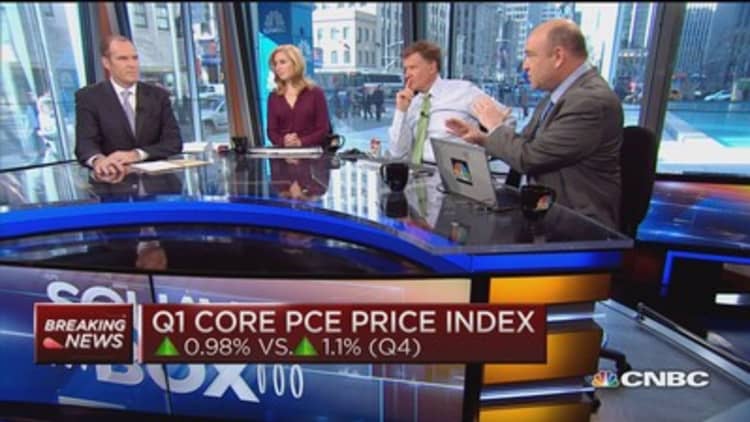


U.S. economic growth braked more sharply than expected in the first quarter as harsh weather dampened consumer spending and energy companies struggling with low prices slashed spending, but there are signs activity is picking up.
Gross domestic product expanded at an only 0.2 percent annual rate, the Commerce Department said on Wednesday. That was a big step down from the fourth quarter's 2.2 percent pace and marked the weakest reading in a year.
A strong dollar and a now-resolved labor dispute at normally busy West Coast ports also slammed growth, the government said.
Read MoreAmericanswant to save, but still fall short
Economists polled by Reuters had forecast the economy expanding at a 1.0 percent rate. While the weak GDP figures could rattle financial markets, the growth slowdown is probably not a true reflection of the economy's health, given the role of temporary factors such as the weather and the ports dispute.
The first-quarter GDP snapshot was released just hours before U.S. Federal Reserve officials conclude a two-day policy meeting. Policymakers at the central bank are expected to acknowledge the softer growth, but shrug it off as temporary in a statement they will issue after their gathering.
While there are signs the economy is pulling out of the soft patch, data on home building, manufacturing, retail sales and business investment suggest the rebound will lack the vigor seen last year when the economy snapped back after being blindsided by cold weather.
At the start of this year, many economists believed the Fed would raise interest rates from near zero in June. Now, most of the guessing centers around September.
Hibernating consumers
The government did not quantify the impact of the weather, the strong dollar and the ports disruptions on growth last quarter. Economists, however, estimate unusually cold weather in February chopped off as much as half a percentage point, with the port disruptions shaving off a further 0.3 percentage point.
Read MoreWeekly mortgage applications drop as homebuyers stall
The weather impact was evident in weakness in consumer spending. Growth in consumer spending, which accounts for more than two-thirds of U.S. economic activity, slowed to a 1.9 percent rate. That was the slowest in a year and followed a brisk 4.4 percent pace in the fourth quarter.
The sharp moderation in consumer spending came even though households enjoyed huge savings from a big drop in gasoline prices. Consumers boosted their savings to $727.8 billion from $603.4 billion in the fourth quarter.
Construction also took a hit from the weather, while lower energy prices, which have cut into domestic oil production, undermined business investment.
Spending on nonresidential structures, which includes oil exploration and drilling, tumbled at a 23.1 percent rate. That was the fastest pace of decline in four years and marked the first contraction since the first quarter of 2013.
The decline in nonresidential structures was driven by mining, exploration, shafts and wells, which plunged at a 48.7 percent pace in the first quarter.
Schlumberger, the world's No. 1 oil-field services provider, has slashed its capital spending plans for this year by about $500 million to $2.5 billion, while competitor Halliburton cut its by about 15 percent to $2.8 billion.
While companies have not given a time frame, economists believe the bulk of the spending cuts were front-loaded into the first quarter, and they expect energy-related investment cuts will present less of a drag on growth in the April-June quarter.

The dollar, which gained 4.5 percent against the currencies of the United States' main trade partners in the first quarter, weighed on trade, as did the West Coast ports dispute. Trade subtracted 1.25 percentage points from first-quarter GDP growth.
Read MoreInvestors on Fed watch as statement, GDP come out
The dollar is expected to remain an economic headwind in the quarters ahead. Economists estimate it will reduce growth by 0.6 percentage point this year.
There was a surprise increase in inventory accumulation, which added 0.74 percentage point to GDP growth.
Inventories increased $110.3 billion from $80.0 billion in the fourth quarter. But the jump suggests inventories will be a drag on growth in the second quarter.

